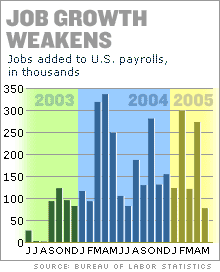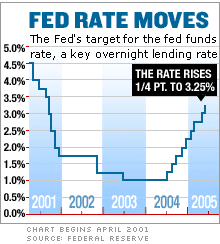 |
 |
|
|
|
|
|
|
| More about jobs and the economy
|
|
|
|
|
|
|
NEW YORK (CNN/Money) -
When the June jobs report comes out Friday, the first number traders and investors will react to is the payroll number: how many jobs the economy generated last month.
But perhaps a more important number to watch will be the hourly earnings number. That tracks not how many people found jobs in June but whether workers were making more money. Economists are betting on a continued pickup in wage growth.
The payroll number, economists say, is typically very volatile. And during the past few months, consensus estimates haven't been close to accurate.
For example, economists were predicting 175,000 new jobs in May and it turned out that only 78,000 were added. A month before that, economists were expecting 170,000 jobs and the actual number wound up being 274,000.
"We've had ups and downs in payroll job growth," said Anirvan Banerji, director of research with the Economic Cycle Research Institute (ECRI). "The month-to-month gyration is inevitable."
This time around economists are forecasting that employers added 194,000 jobs to payrolls, according to Briefing.com.
Regardless of how many new jobs are added, as long as the hourly earnings figure keeps climbing, that could be interpreted as a good sign for most Americans -- and for the broader economy. But it could also raise worries about inflation -- and how aggressively the Fed will raise interest rates going forward.
Economists are forecasting a 0.2 percent increase in hourly wages for last month, after a similar May increase left wages up about 2.6 percent over the past year. By way of comparison, average hourly earnings rose just 1.7 percent year-over-year in early 2004.
Still, if wages keep growing -- and especially if the increase in wages accelerates -- that could give the Fed more reasons to worry about inflation. To that end, despite some recent disappointing payroll numbers, it doesn't appear that Federal Reserve policy-makers see the labor market as weak.
In fact, after it raised short-term rates for the ninth consecutive time last week, the Fed said in its closely watched statement that "labor market conditions continue to improve gradually."
"The Fed is more realistic about [the lack of] prospects for rampant job growth," said John Norris, chief economist with Morgan Asset Management. "Wages have stabilized this year and are growing at a comfortable pace."
Are workers finding better jobs?
Other economists have also noted that the job market, as measured by wage growth, is showing signs of an upturn.
In a report last week, Elise Gould at the Economic Policy Institute wrote that for the first time since the summer of 2001, job growth in industries that typically offer higher-paying jobs such as technical services was higher than in industries like retail which tend to pay lower wages.
"This recently reversed trend suggests that the labor market is finally starting to add better quality jobs than it has in the past few years," Gould wrote. (For more on that trend, click here).
According to the minutes from the Fed's May 3 meeting, central bank members also noted that "real wages and salaries continued to rise," and that "the unemployment rate was projected to hold around its current level with improvements in job prospects expected to lure more workers back into the labor force."
Economists expect the unemployment rate to remain at the relatively low level of 5.1 percent in June.
With that in mind, Dan Laufenberg, chief economist with American Express Financial Advisors, said he expects faster wage growth in June and the coming months since an unemployment rate of about 5 percent is close to being considered full employment.
"Wages have started to show some improvement and you would expect that they would do that with unemployment heading toward 5 percent," he said.
Still, there are signs the job market may still be abnormally sluggish 3-1/2 years after the last recession ended. According to a report from employment recruitment firm Challenger, Gray & Christmas on Wednesday, the number of layoffs announced in June was the highest since January 2004.
Others note that the recent increase in wages is a good sign but that salary growth still lags the overall increases in consumer prices during the past 12 months. So that should lessen, not heighten, inflation worries.
"Wage growth is firm but it's not that elevated," Banerji at the ECRI said.
What's next for the Fed?
With all this in mind, the June jobs report -- and what it says about wages -- could give a lot of clues about how high rates may go.
"If the numbers are good then the Fed may be on target for a 3.75 or 4 percent fed funds rate," Morgan's Norris said.
The Fed raised its target for the fed funds rate to 3.25 percent -- the ninth straight quarter-point increase, and most economists and investors expect the central bank will raise the overnight bank lending rate to 3.5 percent at its next meeting in August.
Laufenberg agreed that the Fed will probably keep raising short-term rates until they hit 4 percent, in part because it doesn't seem higher rates are slowing consumer spending.
Rising wages have a lot to do with that, he noted, adding that there have also been solid increases in broader indicators of salary growth, such as the real personal disposable income and employee compensation figures reported in the most recent gross domestic product (GDP) report for the first quarter.
In other words, there's more to the health of the job market than how many new jobs were added in a given month.
"What's more important to the overall economy is that people that do have jobs still have purchasing power," Laufenberg said.
For more about the Fed and interest rates, click here.
For a look at what's next on the economic calendar, click here.

|